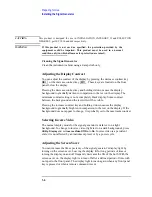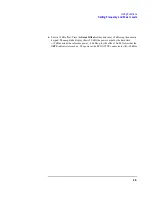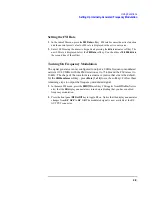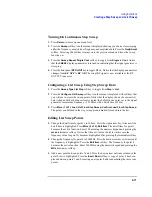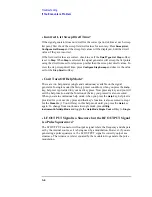
2-6
Using Functions
Setting Up Internally-Generated Amplitude Modulation
Setting Up Internally-Generated Amplitude Modulation
Using this procedure, you will learn how to generate an amplitude-modulated
signal with the following characteristics:
•
carrier frequency set to 1340 kHz
•
power level set to 0 dBm
•
AM depth set to 90%
•
AM rate set to 10 kHz
Setting the Carrier Frequency
1. Press
Preset
to return the signal generator to the factory-defined instrument state.
2. Press the front panel
Frequency
key. Frequency becomes the active function and the
normal preset value for frequency is displayed in the active entry area.
3. Enter 1340 kHz using the numeric keypad and pressing the
kHz
terminator softkey. The
new carrier frequency is shown in the frequency area of the display. You should see
1.340 000 00 MHz
.
Setting the Power Level
1. Press the front panel
Amplitude
key. Amplitude becomes the active function and the
normal preset value for amplitude is displayed in the active entry area.
2. Enter 0 dBm using the numeric keypad and pressing the
dBm
terminator softkey. The
new power level is shown in the amplitude area of the display. You should see
0.00 dBm
.
Setting the AM Depth
1. Press the front panel
AM
key. The first level menu of softkeys is displayed.
2. Press the
AM Depth
softkey. AM depth becomes the active function and the normal
preset value for AM depth is displayed in the active entry area.
3. Enter 90% using the numeric keypad and pressing the
%
terminator softkey. The new
AM depth is displayed below the
AM Depth
softkey. You should see
90.0 %
in the
second line of the softkey.
Summary of Contents for ESG Series
Page 3: ...ii ...
Page 29: ...1 12 Preparing for Use Verifying Signal Generator Operation ...
Page 43: ...2 14 Using Functions Saving and Recalling an Instrument State ...
Page 95: ...3 52 Troubleshooting HP Sales and Service Offices ...
Page 109: ...4 14 Front and Rear Panel Rear Panel Overview ...
Page 111: ...5 2 Hardkey and Softkey Reference ...
Page 135: ...5 26 Hardkey and Softkey Reference Ampl ...
Page 137: ...5 28 Hardkey and Softkey Reference Amplitude ...
Page 139: ...5 30 Hardkey and Softkey Reference Arrow Keys ...
Page 141: ...5 32 Hardkey and Softkey Reference Display Contrast Keys ...
Page 161: ...5 52 Hardkey and Softkey Reference FM ...
Page 169: ...5 60 Hardkey and Softkey Reference Frequency ...
Page 171: ...5 62 Hardkey and Softkey Reference Help ...
Page 173: ...5 64 Hardkey and Softkey Reference Hold ...
Page 175: ...5 66 Hardkey and Softkey Reference Incr Set ...
Page 195: ...5 86 Hardkey and Softkey Reference LF Out ...
Page 197: ...5 88 Hardkey and Softkey Reference Local ...
Page 199: ...5 90 Hardkey and Softkey Reference Mod On Off ...
Page 200: ...5 91 Hardkey and Softkey Reference Mode Mode This front panel key is reserved for future use ...
Page 201: ...5 92 Hardkey and Softkey Reference Mode ...
Page 203: ...5 94 Hardkey and Softkey Reference Numeric Keypad ...
Page 225: ...5 116 Hardkey and Softkey Reference Power Switch ...
Page 235: ...5 126 Hardkey and Softkey Reference Preset ...
Page 241: ...5 132 Hardkey and Softkey Reference Pulse ...
Page 245: ...5 136 Hardkey and Softkey Reference Recall ...
Page 247: ...5 138 Hardkey and Softkey Reference Return ...
Page 249: ...5 140 Hardkey and Softkey Reference RF On Off ...
Page 255: ...5 146 Hardkey and Softkey Reference Save ...
Page 275: ...5 166 Hardkey and Softkey Reference Sweep List ...
Page 311: ...6 10 Options and Accessories Upgrade and Retrofit Kits ...
Page 312: ...7 1 7 Operation This chapter is reserved for future use ...
Page 313: ...7 2 Operation ...
Page 322: ...8 9 Safety and Regulatory Declaration of Conformity Declaration of Conformity ...
Page 341: ...9 18 Specifications HP ESG Series Signal Generators Specifications ...



